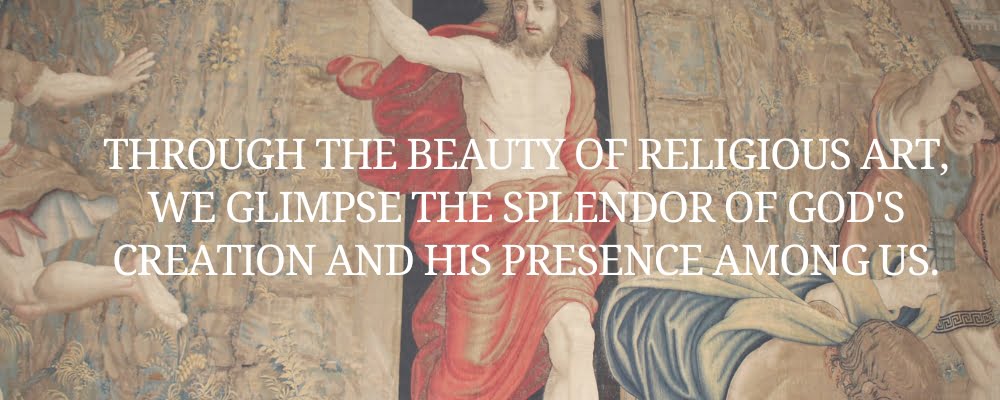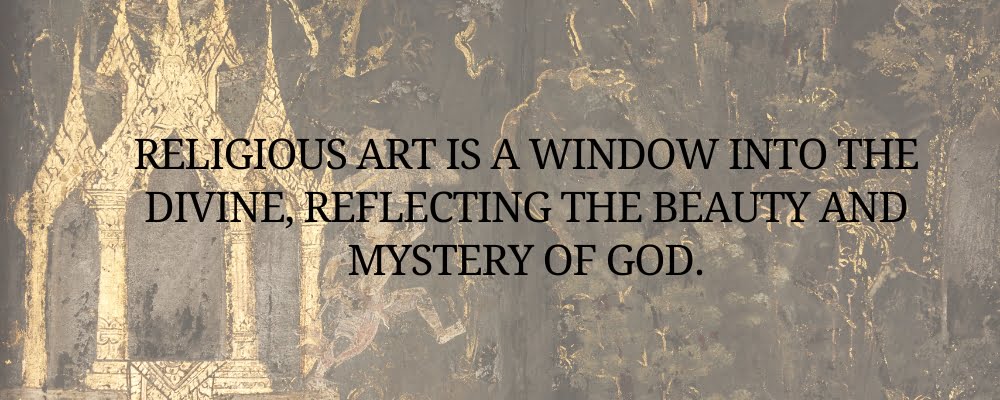No products in the cart.
Christian Spirituality in Religious Art and Iconography
This post contains paid and/or affiliate links. I make a small commission at no extra cost to you. Please see our Privacy Policy.
Religious art has played a significant role in Christianity, serving as a powerful medium to express and explore the faith. From the early days of the Christian church to the present, Christian Spirituality in Religious Art and Iconography visual arts have been used to convey important religious themes, educate the faithful, and foster a deep connection with the divine.
Christian art takes various forms, including paintings, sculptures, illuminated manuscripts, and icons. These artistic expressions visually represent deeply held beliefs, symbolize critical religious figures and scenes, and allow believers to engage with their faith profoundly.
Whether a beautifully painted icon or a meticulously crafted sculpture, Christian art captures the essence of Christian expressions through its aesthetics and symbolism.

The development of Christian art has been influenced by different factors throughout history. From the resistance to the use of images in early Christianity to the theological debates within the church, these influences shaped the evolution and diversity of religious art.
Today, Christian art continues to evolve and take on new forms, including contemporary expressions that explore Christian themes through various artistic mediums.
The world of religious art and iconography, explores the significance of icons in Christian art, the influence of early Christian art and iconography, the role of iconography in Byzantine art, and the contemporary expressions of Christian art. Join us as we unravel the visual arts’s beauty, symbolism, and enduring power in expressing Christian faith.
Key Takeaways:
- Religious art has been an integral part of Christianity since its early days.
- Christian art encompasses various forms, including paintings, sculptures, illuminated manuscripts, and icons.
- Icons are unique in Christian art, particularly in the Eastern Orthodox Church.
- Early Christian art adapted Roman motifs and styles while depicting distinctively Christian content.
- Byzantine art placed a strong emphasis on religious iconography.
The Significance of Icons in Christian Art
Icons are unique in Christian art, particularly in the Eastern Orthodox Church. These sacred paintings depict Christ, the Virgin Mary, scenes from the Bible, or the lives of Saints. Icons serve as a spiritual link, connecting worshippers with God.
The veneration of icons is an essential part of the liturgy and piety in the Eastern Orthodox Church. They are displayed in churches and homes, visually representing the divine presence.
The act of venerating an icon involves showing reverence, respect, and prayer to the depicted figure. It deepens the spiritual connection and fosters a sense of devotion.
The significance of icons goes beyond their religious symbolism. They are characterized by a fixed style and adhere to traditional principles of painting.
Icon painting is viewed as a holy skill practiced by artist monks in cloisters following specific schools of icon painting. The strict adherence to technique and style ensures that the icons maintain their sacred essence and convey the timeless truths of the Christian faith.

The Theology of Icons in the Eastern Orthodox Church
- The veneration of icons dates back to the early Church but became a subject of heated debate in the Byzantine Empire during the 8th and 9th centuries.
- Iconoclasts argued against icons, seeing them as idols or objects of worship that violated the prohibition of graven images.
- The iconoclastic controversy led to a theology of icons, defending their use and veneration. This theology emphasized the distinction between worship (latria), reserved for God alone, and veneration (dulia), offered to the icons as representations of the divine.
- The theological arguments and the defense of icons ultimately prevailed, solidifying their central role in the Eastern Orthodox Church.
The Eastern Orthodox Church views icons as a window to the spiritual realm and a means of encountering the divine presence. They promote reverence, contemplation, and a deepening of faith.
The fixed style and traditional principles of iconography ensure the continuity of religious imagery, connecting present-day worshippers with the rich history and traditions of Christianity.
Early Christian Art and Iconography
Early Christian art, known as Paleochristian art, emerged in the second and third centuries. It was created by Christians or under Christian patronage, marking the beginning of a distinct visual language that conveyed the message of Christianity.
Early Christian art drew influence from the Roman culture surrounding it, adapting Roman motifs and styles to create a uniquely Christian aesthetic. Similar media, such as frescos, mosaics, sculptures, and illuminated manuscripts, allowed early Christian art to flourish and spread its message.
Distinctively Christian in content and context, early Christian art often depicted biblical scenes, Jesus, the Virgin Mary, and saints. These depictions served to educate the faithful and strengthen their connection to the Christian faith.
Symbols and symbolic representations were prevalent in early Christian art, enabling artists to convey complex religious messages. These symbols and allegories added depth to the artwork and served as visual aids for theological concepts.
Critical Characteristics of Early Christian Art:
- Adaptation of Roman motifs and styles
- Depiction of biblical scenes, Jesus, the Virgin Mary, and saints
- Use of symbols and symbolic representations
- Similar media to the surrounding Roman culture
Despite its significance, the availability and survival of early Christian art may have been limited due to persecutions faced by Christians and religious restrictions on producing graven images.

Iconography in Byzantine Art
Byzantine art, which emerged in the Byzantine Empire (4th to 15th centuries), strongly emphasized religious iconography. Byzantine icons, known for their elaborate and two-dimensional style, served as visual representations of religious beliefs and were used as objects of veneration.
Byzantine iconography followed strict rules and employed specific symbols to represent Christ, the Virgin Mary, and saints. These symbols held deep theological significance and conveyed spiritual ideas to the faithful.
For example, the use of gold leaf backgrounds in Byzantine icons represented the heavenly realm, while colors like red symbolized divinity and green represented earthly life.
Key Features of Byzantine Iconography:
- Elaborate and Two-Dimensional Style: Byzantine icons were characterized by their intricate details and flat, frontal figures, which aimed to convey the divine nature of the subjects.
- Strict Iconographic Rules: Specific symbols, gestures, and postures were used to represent Christ, the Virgin Mary, and saints, ensuring consistency and uniformity in their portrayal across different icons.
- Theological and Spiritual Significance: Byzantine icons were not mere artistic representations but held deep religious meaning. They conveyed theological concepts and spiritual ideas and acted as a means of connecting with the divine.
- Rich Symbolism: Byzantine icons employed various symbols to convey complex ideas. These symbols had specific meanings that were understood by the faithful, fostering a deeper understanding of the Christian faith.
Byzantine iconography profoundly impacted the development of Christian art, particularly in Eastern Orthodox traditions. The reverence and attention to religious symbols in Byzantine art set the foundation for the visual representation of Christian beliefs. They influenced the artistic expression of faith for centuries.
Contemporary Expressions of Christian Art
While traditional Christian art and iconography continue to be revered and practiced, contemporary artists have also found expression in exploring Christian themes through various artistic mediums. Contemporary Christian art encompasses various styles, from realistic paintings to abstract sculptures.
Artists often draw inspiration from biblical narrative, theological concepts, and personal spirituality, infusing their work with modern interpretations of Christian imagery.
This artistic movement allows for artistic freedom and interpretation, resulting in diverse representations of Christian imagery. Contemporary Christian artists embrace their creative autonomy, pushing the boundaries of traditional religious art.
Through their artwork, contemporary artists aim to:
Engage viewers on a deeper level by presenting familiar Christian narratives in fresh and meaningful ways
Provoke thought and encourage dialogue about faith, spirituality, and the role of Christianity in contemporary society
Evoke a sense of connection with the divine, inviting viewers to reflect on their relationship with God
Challenge preconceived notions by offering alternative perspectives and interpretations of Christian themes
Express the complexities of faith in a rapidly changing world, addressing contemporary issues and concerns through their art.
This fusion of traditional and contemporary expressions of Christian art contributes to religious art’s ongoing evolution and relevance in the modern world. It embodies the idea that artistic freedom and adaptability are essential for faith traditions to thrive and resonate with diverse audiences.
Conclusion
Religious art and iconography are central to Christian expressions, using visual arts to convey the depths of faith. From early Christianity to the present, these arts depict key religious themes, educate the faithful, and foster divine connection. Eastern Orthodox icons, Roman motifs in early Christian art, and contemporary Christian themes showcase the diversity of religious art.
Through paintings, sculptures, and manuscripts, Christians express beliefs, inspire worship, and invite contemplation. The intricate symbolism in religious art serves as a visual vocabulary, deepening spiritual understanding.
Contemporary artists explore Christian themes, blending tradition and modernity, ensuring religious art’s relevance today.
In conclusion, religious art remains vital to Christian expressions, engaging the senses and transcending language and culture to communicate faith and deepen spiritual bonds.
FAQ
What is religious art?
Religious art refers to visual artworks that depict religious themes, symbols, or figures and serve to express and explore spirituality and faith.
What is the significance of icons in Christian art?
Icons are unique in Christian art, particularly in the Eastern Orthodox Church. They are sacred paintings that depict Christ, the Virgin Mary, scenes from the Bible, or the lives of Saints, and serve as a spiritual link between God and the worshipper.
How does early Christian art differ from Roman art?
Early Christian art, known as Paleochristian art, adapted Roman motifs and styles but had distinctively Christian content and context. It often depicted biblical scenes, Jesus, the Virgin Mary, and saints, and used symbols and symbolic representations to convey religious messages.
What is the role of iconography in Byzantine art?
Byzantine art placed a strong emphasis on religious iconography. Byzantine icons served as visual representations of religious beliefs and were used as objects of veneration. They followed strict rules and employed specific symbols to represent Christ, the Virgin Mary, and saints, conveying theological concepts and spiritual ideas.
How does contemporary Christian art differ from traditional Christian art?
Contemporary Christian art encompasses various styles and allows for artistic freedom and interpretation. Artists draw inspiration from biblical narrative, theological concepts, and personal spirituality, resulting in diverse representations of Christian imagery.
What is the purpose of religious art in Christian expressions?
Religious art serves as a vehicle for conveying the depths of the Christian faith. It depicts critical religious themes, educates the faithful, fosters a connection with the divine, inspires worship, and invites contemplation.










